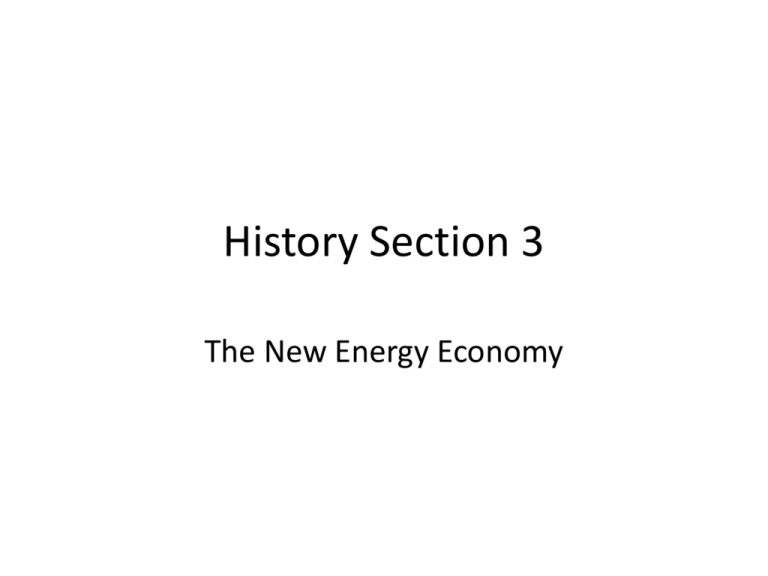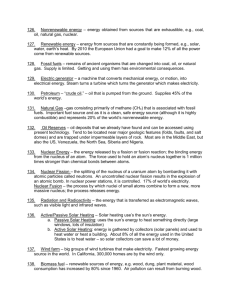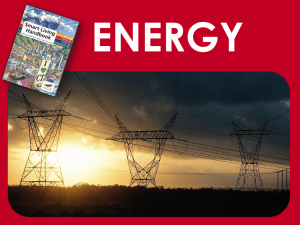History Section 3
advertisement

History Section 3 The New Energy Economy Stuff from the test • M. King Hubbert: predicted that oil production would irreversibly decline between 1965 and 1971 • Nitrogen:78%(most), Oxygen: 21%(second), Greenhouse gases: 1%( least) • The US consumed about 97 quads of energy in 2012 Renewable energy Summary • • • • Renewable energy: energy from sustainable, natural elements Renewable energy industry growing, esp solar and wind But worldwide generation slow Percent of global energy from renewable energy actually fell a bit between 1990 and 2009 • “achieving goal of halving global energy related CO2 emissions by 2050 would require double renewable generation by 2020” • Fig 12, pie chart of sources of energy Wind Power • Fasted growing electric power generation • In US, b/c of: – Investment tax credits – Federal production – Grant and loans for farmers, ranchers, and rural businesses with wind power – Renewable Portfolio standards, state regulations that require a certain amount of energy produced by renewable power, adopted by 30 states 1970’s oil inspired push for alternative energy As result, wind energy increased in CA early 80’s Another increase in 90’s with research connecting climate change and fossil fuels Wind Power • Collected from turbines, and by spinning blades with wind • Blades connected to drive shaft, which turns the generator and makes electricity • Benefits: – Clean, small environmental impact – Wind producers pay landowners rent giving them extra income Drawbacks: - intermittency, not easily controlled - Bird deaths - Ugly-looking PV vs CSP Solar Power photovoltaic production( PV) - solar cells that convert sunlight directly to electricity - cells are grouped into panels - fastest-growing renewable energy tech between 2000 and 2011 - 2011, Germany and Italy over half global capacity Solar thermal/electric power plants - aka Concentrating solar power (CSP) - concentrate solar energy to heat a fluid which makes steam to turn a generator - built a few in the 80’s, but only re-emerged in US and Spain Question Explain the difference between PV solar power and solar thermal power Solar Power • According to IEA, solar could provide up to 1/3 energy demand after 2060 ( This was a question on the test!) Benefits: - no fuel cost( still operating cost though) - no air pollution - low environmental impact - “peak shaving”- extra energy with extra sunlight Drawbacks - not always reliable( night, clouds) Biofuels • Made from biomass: renewable organic matter derived from plants or animals • Ethanol: alcohol fuel from grain sugars, esp. corn – – – – Process of distilling ethanol not entirely efficient Usually blended with petroleum fluids Nearly all gas sold contains some ethanol Any gas-powered engine can use gas with 10% ethanol Biodiesel: renewable fuel made from vegetable oils, fats, or greases - Mostly soybean oil in US - Somewhat bad for environment though, forests cut to grow soy for biofuel - Provides about 3% of transport fuel Question What is ethanol? Geothermal Energy • • • • Heat stored in rock and trapped in liquids like water or brine Heat used to generate electricity 3 uses: direct use, electricity generation, geothermal heat pumps Direct use: – Take hot water to bath with, cook with, generate electricity – Usually to heat buildings when hot water pumped through – 95% of buildings in Reykjavik use direct heating Electricity generation: - Led by US 20x increase predicted between 2011 and 2050 Geothermal heat pumps - Use temp. diff. between above ground air and subsurface to transfer eat to or from te ground Can transfer heat to home during winter, heat away from home during summer Electricity grid and How it works • Electricity grid: a complex machine that produces power safely and consistently • Power vs energy: – Power is rate of energy use – Energy is quantity of electricity used over a period of time – Energy is power times time Transfer of electricity: Generated at power plant into a large current Electricity generated is transferred by a grid: network of transmission lines, generators, and localized distribution lines Generators-transmission lines over long distance localized distribution lines individual homes or buildings that use the electricity The Grid • Needs to match peak demand for electricity( usually in evening) • Have to balance technical, legal, and economic problems • Had down to science with fossil fuels • Changing with need for cleaner generation • Problem: clean energy not always reliable ( remember sun and wind?) • To address concerns, 2 solutions: Smart Grid and Energy Storage Smart Grid • Uses info and communication between generator and consumer to increase efficiency, reliability, and sustainability • Have to work with customers using strategy – Demand response: to alter consumption patterns in response to diff. prices or reliability events – Used to reduce peak demand – Demand shift: utility asks a customer to avoid electricity use at times of peak demand Energy Storage • 2 major problems: cost and market acceptance • Changing role in future grid operations • Flywheels – Rotate to store rotational energy – More energy stored as speed accelerates Compressed air energy Storage - Stores compressed air in an underground cavern or aboveground system of pipes When stored energy needed, compressed air mixed with fuel, and combusted to produce energy Conventional pumped Hydro Storage - Pumps water from a low reservoir to a higher one during off-peak hours Lets it flow back during peak hours Energy Storage P. 2 • Capacitors( Flux capacitor from back to the future, anyone?) – Store energy in an electric charge – Useful for stabilizing voltage on grid Batteries - Limited life Bridge power applications Electric vehicles - Charged in a controlled manner Can store energy in battery and release energy However, storage capacity is limited Short life cycle of battery A Flux Capacitor powered by plutonium Why are public utilities regulated? • • • • Rates are regulated through gov’t Limit the company’s profits Limits consumer choice States give utilities protected monopolies, but highly regulated Traditional Utility Regulation • almost every state has different approach to regulation • Cant really accurately generalize • Most use some type of “cost-of-service” regulation – Serve through a monopoly or a number of competing suppliers Traditional regulation, rates set by state agencies called Public Utility Commissions (PUCs) Set rates by how much money the plant needs to operate Gas and Oil extraction • Traditionally “exploring”, not sure where exactly oil is • Use new seismic imaging, but drilling is only way to identify for sure • Shale Gas changes this – Turned exploration to farming – Shale Gas is gas residing in the source rock – Only recently is it cost efficient to get oil and gas from rock – Use horizontal drilling techniques and hydraulic fracturing – Shale gas has moved from supplying only 1%(2000) to 25%(2011) Future of Energy Efficiency • Reduce amount of energy it takes to generate products • one of the greatest energy sources: do more with less • About 90% of energy used in incandescent bulbs is wasted (TEST QUESTION FROM SCRIMMAGE!!!) • Compact fluorescent lights and light-emitting diodes are better replacements • Also reduce energy lost in energy production • For every 9.5 units of energy produced, plant consumes 100 units • Also improve energy efficiency in transportation with Corporate average fuel economy standards Question How much energy is wasted in traditional incandescent light bulbs? Nuclear power Renaissance • In 50’s, nuclear power thought as solution to all energy problems • Nuclear generators used to power subs • Admiral Hyman Rickover helped create first sub, US Nautilus powered by nuclear power, in 1954 • By late 1960’s, 50 nuclear power plants were built Downfall of Nuclear Power with Disasters • Three Mile Island, New York 1979 – Partial meltdown – Thousands of residents fled – Halted rapid growth of nuclear power in US • Chernobyl, Ukraine 1986 – Really famous – 110,000 evacuated, 220,000 more in later years – Region closed off, probably for thousands of years til safe again • Fukushima 2011 – Earthquake and tsunami hit Japan – Destroyed plant, serial fires, meltdowns, explosions – Operator Tokyo Electric Power Company criticized Question What country was the Chernobyl disaster located? Nuclear Power Today • Nuclear power supplies over 11% of world’s total electricity • 39 new reactors commissioned between 2000 and 2010 – Mostly in asian countries – Of 60 reactors currently under construction, 80% in China, India, South Korea, and Russia In 2013, US has 64 nuclear power plants and 104 working reactors In 2012, construction permits issued for 4 new reactors - first permits in 34 years Small Modular Reactors • Passive cooling and passive safety features that don’t need human intervention to work • Safer, can be shut down if humans evacuate • Possible future for nuclear plants But Wait, there’s more! Study tips • I know you all have lives outside of Acadeca, but for the test, here’s a few tips • Over next month: – Use Robby’s awesome quizlet to review – Hold on to handouts – Try to read over the ENTIRE section once( 30 min per section, about 1 and a half hours for the whole thing, but you have a month!) – Remember important people, and generally what they did – They test on minute details, pay attention to those Studying Tips • During Cram week: – Don’t read over entire section: too big to retain everything, use only for reference – Look over section summaries, good for refreshing memory – Go over worksheets – Make a timeline, with details, esp. Acts and Disasters Additional stuff: This is a smaller section, don’t stress too much Powerpoints are available, ask Miss Herbert or me If confused on anything, ask the All knowing Alex, Rockin’ Robby, or (adjective that starts with sh) Chanel Participate in the review game tomorrow, check your weaknesses in the practice test








